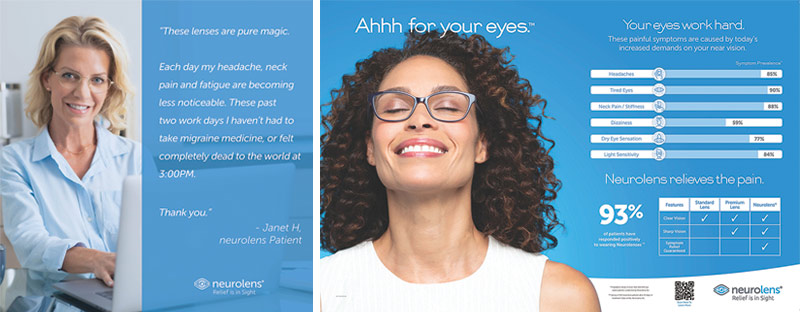Sponsored by Neurolens
Lori Passarelli, ABOM

This final article in the series “Neurolens: Relief is in Sight” will review what we have learned thus far about eye misalignment, the trigeminal nerve and proprioceptive conflict, the Neurolens Measurement Device, Gen 2 (NMD2) and Neurolenses. Specifically, we will review how incorporating Neurolens technology can add value to your practice while providing patients with exceptional care.
The average American spends an estimated seven hours a day staring at digital device screens. The majority report experiencing reduced visual acuity and painful symptoms of eye misalignment, which we commonly call Digital Vision Syndrome (DVS). In fact, in a study of over 160,000 people, over 80 percent reported experiencing symptoms of eye misalignment at least some of the time; yet only 1 in 10 reported symptoms to their eye doctor. The symptoms of DVS—headaches, eye strain, neck and shoulder pain, motion sickness and dry eye sensation can often be traced back to vision—and specifically the trigeminal nerve.
The trigeminal nerve is the largest of the 12 cranial nerves. Proprioceptive information is sent to the brain via the trigeminal nerve; but when there is a proprioceptive mismatch between misaligned eyes and your vestibular and muscular systems, this creates a neural conflict and leads to an inaccurate gaze response. This leads to an overstimulation of the trigeminal nerve, and this overstimulation leads to a painful stimulation of several parts of the face and neck. This is why these common symptoms can so often be tracked back to binocular vision issues. Standard industry practice is to employ a blue light filter to relieve DVS symptoms, but this does not address the underlying binocular vision issues.
Standard cover tests have very low inter-examiner repeatability due to their incredibly subjective nature. These tests also typically miss smaller phorias, leaving many patients with small amounts of uncorrected eye misalignment. This results in unnecessarily compromised visual acuity as well as painful symptoms. Neurolens addresses common binocular vision issues using a three-step process. Step one is efficiently identifying patient symptomology using a basic online symptom screener that every patient can complete in minutes. This information goes directly to the Neurolens Measurement Device, Gen 2—or NMD2—ready for step two, which is accurately and objectively measuring the patient’s level of misalignment. The NMD2 is an objective, accurate and repeatable way to measure eye misalignment as small as 0.01 Prism Diopters.
Most importantly, step three is correcting eye misalignment with a proven lens solution. Neurolenses address binocular vision issues by providing a contoured prism lens design that gradually delivers more prism in the lens corridor from distance to near. Neurolenses are proven to have a profound impact on a patient’s visual clarity and comfort. In fact, 93 percent of patients responded positively to wearing Neurolenses. Over 81 percent of patients suffering from chronic daily headaches reported their symptoms were substantially reduced or “basically gone” after wearing Neurolenses for 90 days in a Computer Vision Syndrome (CVS) study.
While Neurolenses with contoured prism have repeatedly shown efficacy in relieving symptoms as a therapeutic offering, new evidence suggests that there is also an opportunity to expand this technology to an even broader population focused on visual performance and productivity improvement. In a parallel arm study evaluating reading speed at baseline, after seven days of lens wear, the mean (±SD) improvement in reading speed with Neurolenses was almost 70 percent higher than the mean (±SD) improvement in reading speed with other premium lens designs.
Neurolens, recognized in 2022 as one of the 30 fastest growing private companies in the health care industry by Inc. Magazine, is confident that appropriately addressing growing binocular vision issues will become a standard of care in this industry, unlocking patient outcomes and practice growth for Neurolens providers. Learn more about becoming a Neurolens provider at neurolens.com, and experience dramatic patient outcomes and practice success.













